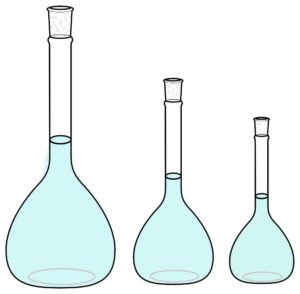Many chemical reactions are carried out in solution or in the liquid state. Recall, in order for a chemical reaction to occur, bonds must break and new bonds must form. The most common concentration unit used in the chemistry lab is molarity, M. Molarity is defined as the amount of solute dissolved in enough solvent to form 1 liter of solution.
In the lab, solutions are prepared using volumetric flasks (see the figure below). The flasks come in sizes ranging from 1.00 mL up to 4,000.00 mL (4.00 L).
To prepare a one molar, 1.00 M, solution of MgCl2, measure out 1.00 mole of MgCl2. One mole of MgCl2 is equivalent to 95.21 g of MgCl2. Place the 95.21 g of MgCl2 into a 1.00 L volumetric flask and then add enough solvent to dissolve the salt. Once the salt is dissolved, add solvent to the mark on the volumetric flask. It is important the solution is mixed well. In addition, it is important you add the solute before adding all of the solvent. Recall, the solution is both the solute and solvent and must be equal to 1.00 L. If the solute were added to 1.00 L of solvent, you would not have a 1.00 M MgCl2 solution.
Molarity can be used as a conversion factor. If we know the molarity and the volume, the number of moles can be calculated. If we know the molarity and the number of moles of solute, the volume can be calculated.
and
\(\displaystyle Volume\;of\;solution\;=\frac{Moles\;of\;solute}{Molarity}\)
To calculate the molarity of a solution by dissolving 3.65 g of HNO3 in water and then diluting to a final volume of 100.00 convert the 3.65 g of HNO3 to moles. The molar mass of HNO3 is 63.01 g/mole. The number of moles of HNO3 is:
Convert the 100.00 mL to L. 100.00 mL = 0.10000 L. To calculate the molarity, divide the moles of HNO3 by the volume in liters.
How many grams of H2SO4 are required to prepare 50.00 mL of a 0.640 M aqueous solution? First, we convert the volume of the solution to liters.
Multiply the molarity and volume to calculate the number of moles of H2SO4.
Finally, convert H2SO4 to grams. This is equal to 3.14 g H2SO4.
Please see the videos and exercises below. Next, we will discuss dilution.
Dilution
In the lab, you will notice solutions of different concentrations. Many of these solutions are prepared from more concentrated solutions as needed. For example, aqueous HNO3 is purchased as a concentrated 15.8 M solution. To prepare smaller concentrations, like 6.0 M, 1.0 M, or 0.1 M, the concentrated solution is diluted. When a more concentrated solution is diluted, the number of moles of solute remains constant–it is the volume that changes when solvent is added.
M1 x V1 = M2 x V2
M1 is the initial molarity, V1 is the initial volume, M2 is the final molarity, and V2 is the final diluted volume. M1 is always the more concentrated solution and M2 is the concentration of the diluted solution. For example, a 6.00 M HCl solution is diluted to a 50.0 mL solution with a concentration of 1.50 M. How much of the 6.00 M HCl was required? Rearrange the equation to solve for V1.
To prepare the solution, 12.5 mL of the 6.00 M HCl would be measured using a calibrated pipet and added to a 50.00 mL volumetric flask. The solvent would then be added to the calibration mark on the volumetric flask. When preparing diluted solutions from strong acids, it is best to first add some water to the volumetric flask before adding the acid due to the large amount of heat that is released when diluting a strong acid. In other words, always add strong acid first to water, and then dilute to the calibration mark on the volumetric flask with more water. In addition, it is best practice to prepare all solutions in a fume hood.
Click Here for the Concentration Units: Molarity Worksheet
Before working on the exercises, you might want to view the following videos:
Exercises
Exercise 1. What is the concentration, M, of an aqueous solution prepared by adding enough solvent to 4.75 g of CaCl2 to make 250.00 mL of solution.
Exercise 2. How many moles of glucose are present in 155 mL of 0.85 M glucose (C6H12O6)?
Exercise 3. How many grams of boric acid (H3BO3) are present in 245 mL of 0.450 M H3BO3?
Exercise 4. How many mL of 0.145 M NaCl solution contain 2.35 g of NaCl?
Exercise 5. What volume of solution, in mL, would result from the dilution of 25.00 mL of 3.50 M NaOH to 0.100 M NaOH?
Exercise 6. Calculate the final volume if 5.00 mL of 1.65 M CaCl2 is diluted to a final concentration of 0.105 M.
View Solutions/Answers to Exercises
Back to General Chemistry 1 Study Guide List
Back to Reactions in Aqueous Solution
Back to Home Page

